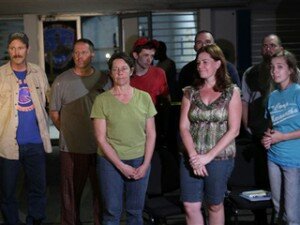Stop the racist attacks on our children
American Indians, Featured — By Valerie Taliman on March 11, 2010 at 5:48 amOriginally published in Indian Country Today
Just as we think we’re making progress, another hate crime rears its ugly head. And this time, it’s against our children.
Last week the Web site UsedWinnipeg.com ran an advertisement headlined “Native Extraction Service” with a photograph of three young Native boys. The service offered to round up and remove First Nations youth like wild animals, and “relocate them to their habitat.”

This online classified ad offered the free removal and relocation of aboriginal youth from parts of Winnipeg. CBC News has blurred the faces in the picture. The ad has since been pulled down. (UsedWinnipeg.com/CBC) Read more
The text of the ad read: “Have you ever had the experience of getting home to find those pesky little buggers hanging outside your home, in the back alley or on the corner??? Well fear no more, with my service I will simply do a harmless relocation. With one phone call I will arrive and net the pest, load them in the containment unit (pickup truck) and then relocate them to their habit.”
They’re talking about our children.
| It’s a classic hate crime, carried out for the sole purpose of inciting racism and hate against indigenous peoples. |
The message is clear: Native people are like pests or vermin, and can be disposed of by simply calling a free service to have them “extracted.”
It was the cyberspace equivalent of a “Wanted” poster, reminiscent of bounties once paid for Indian scalps in the old West. And in my view, it’s a classic hate crime, carried out for the sole purpose of inciting racism and hate against indigenous peoples.
First Nations leaders from Manitoba Keewatinowi Okimakanak said they want police to investigate the ad as a hate crime. They are joined by an outcry from Native leaders in Washington state and Indian country at-large who know that hate often translates to violence.
Ironically, the photo that UsedWinnipeg.com posted on its site was stolen from Longhouse Media, a nonprofit arts and media organization based in Seattle, Wash., with a stellar record for making quality films about Native people by Native people.
Those three minors labeled as “pests” actually won awards for their first documentary film, “March Point,” which tells their poignant coming of age story in a Native American community near Seattle poisoned by industrial pollution. The photo was part of a copyrighted media kit created to promote the film, and clearly showed their faces.
Tracy Rector, Longhouse Media executive director, said the use of their photo in such a “hateful and demeaning way was deeply hurtful to these young men and their families, and to the Native community as a whole.
“This ad could intimidate and incite violence against indigenous youth in North America, and we are joining with Manitoba chiefs to call for an end to hate crimes such as these. We want to see the perpetrators brought to justice.”
Author and poet Sherman Alexie, a founding board member of Longhouse Media, called for collective action. “As much as the world has changed for indigenous people in good ways, there are still many violent and hateful folks out there who seek to harm us, and we must condemn them in print and in action, and we must do this together.”
While the legal rights of these young men were violated, UsedWinnipeg.com is protecting the identity of the racist person who placed the ad. The online publication admits that while they monitor their sites, “this ad slipped through the cracks.”
| Not a single person thought there was something horribly wrong with this ad? No one? |
As a former newspaper editor, I can tell you that’s a shoddy excuse. Does no one read the content before it is published? Sales representatives, copy editors and managing editors are responsible for their content. Not a single person thought there was something horribly wrong with this ad? No one? Clearly, the editorial staff needs some cultural sensitivity training.
People who minimize the impact of the racist ad are ignoring the fact that hundreds of Native women have gone missing or been murdered in Canada. The Stolen Sisters project, with the help of Amnesty International, exposed this dark side of Canada’s human rights record in 2004 with a scathing report.
More than 500 aboriginal women have been murdered or gone missing in Canada over the past 20 years. A Native woman in Canada is five times more likely to die a violent death than a woman of any other race. In the U.S., one in three Native women will be raped in their lifetimes, according to Justice Department statistics.
Yet Canadian officials have done little to help. If 500 white women had been kidnapped and brutally murdered, you can bet there would be a national outcry.
Walter Lamar, a twice-decorated FBI special agent and former national director of law enforcement for the Bureau of Indian Affairs, said it was hard to imagine why a news organization would publish such a sinister advertisement.
“Those willing to demonstrate their hate publicly are equally capable of violence,” said Lamar, who now owns a firm that specializes in helping to reduce violence and drug abuse on reservations. “As a former FBI agent and Blackfeet Nation citizen, I have seen firsthand the carnage left by those consumed by racist hatred. History can produce example after example of racist hatred being translated to violence.”
He ought to know – Lamar’s career includes working crime scenes for the 9/11 terrorist bombings, the hunt for Green River serial killer in Washington, the Oklahoma City bombing by Timothy McVeigh, and the fiery siege of the Branch Davidian compound near Waco, Texas.
Walt and I grew up on the Navajo Nation, where hate crimes have been commonplace for more than 100 years. In towns bordering our reservation like Gallup and Farmington, N.M., brutal crimes against our people date back to the 1870s when white residents used Navajos for target practice.
The worst of these crimes occurred in the 1970s, when three Navajos were found bludgeoned, mutilated and burned. They had been tortured with firecrackers in their noses and private parts by three white Farmington teenagers. The history of hatred and attacks on our people was chronicled in Rodney Barker’s book “Broken Circle.”
In 2006, yet another Navajo man was beaten to death in Farmington by three white men in a racially-motivated hate crime. They were eventually convicted, but most often we do not see justice for crimes committed against us.
The U.S. Commission on Civil Rights recognized the problem and proposed a large-scale investigation of racism and hate crimes in border towns of seven states in 2003, but the Bush administration refused to fund it.
| More than 500 aboriginal women have been murdered or gone missing in Canada over the past 20 years. |
In response, the Navajo Nation recently formed its own Navajo Nation Human Rights Commission and is moving forward to document these crimes, and to foster greater public awareness and improved relations with border towns.
Everyone who believes in human rights must speak out against hate crimes and demand an end to the racism, hatred and violence. Our silence is our consent.
Tags: aboriginals, american indian, Indian country, natives, race, racism, Talking about RaceAuthor: Valerie Taliman (2 Articles)

Valerie Taliman, Navajo, is president of Three Sisters Media, which offers publishing, social media and public relations services. She is also an award-winning journalist specializing in environmental, social justice and human rights issues. She is based in Albuquerque, N.M. Contact her at [email protected].


 Share This
Share This Tweet This
Tweet This Digg This
Digg This Save to delicious
Save to delicious Stumble it
Stumble it





 Neither conspiracy nor post-racialism
Neither conspiracy nor post-racialism Lights, camera, Haiti
Lights, camera, Haiti Ten Baptist workers arrested for child trafficking in Haiti
Ten Baptist workers arrested for child trafficking in Haiti Opening salvo from a token indian?
Opening salvo from a token indian?







